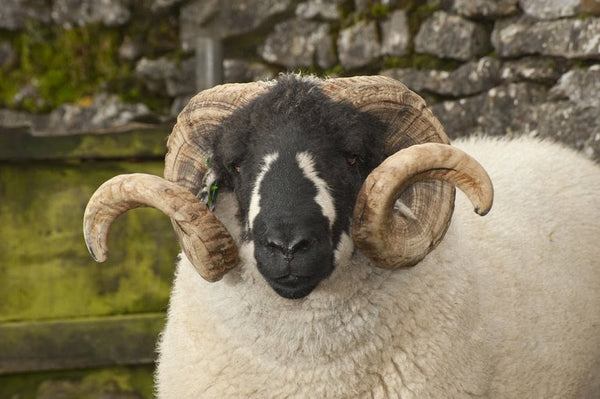Know Your Fiber: Lonk Wool
Posted on March 01 2023

With their curlicue horns on both rams and ewes, black faces and white wool, Lonk sheep are simply striking. Even their name is notable, coming either from the Middle English word wlonk meaning proud or bold, or possibly from a no longer used local dialect, meaning lanky. Found only in three northern England counties, this sheep and its ancestors has provided for generations of sheep farmer in the Pennines.
Originating in Lancashire, Lonk are a hill sheep breed that live in the higher elevations of the Pennines. Some flocks can also be found in the neighboring counties that the Pennines cross through, including Yorkshire and the Peak District of Derbyshire. They are an extraordinarily hardy breed that can live year-round in the moorland and tundra climate of the Pennines highlands. Apart from a few outcroppings in the high hills settled by farmers, much of the higher elevations have poor grazing for most breeds of sheep. However, Lonk sheep thrive of the coarse grasses and rushes of the area and are one of the few sheep that can be successfully raised in that environment. Raised as both a meat and wool sheep, it remains a popular breed for small to medium-sized farms in the region.
Lonk is known as one of the black-faced breeds of the UK. There are a number of black-faced sheep, including Lonk, populating northern England and Scotland and little agreement on where the genes that gave these sheep their black faces came from. The strongest current argument from agricultural historians is that they may be descended from the wild Argali sheep native to central Asia. There is some thought that Argali sheep bred with domesticated sheep, which then made their way westward via trade and settlement to Europe. The same theory posits that Danes brought over the first black-faced sheep to what are today the British Isles around the 9th century.
Regardless of where black-faced sheep originated, they were not uncommon in northern England by at least the medieval period. The first historical mention of them was in the 12th century sheep herd records kept by Cistercian monks at Whalley and Sawley Abbey in Lancashire. The abbey was in Lancashire, and as Lonk can be found a relative hop, skip, and a jump away from the abbey, it is certainly a possibility. That said, it is also a possibility that it is descended from other black-faced breeds, such as the Scottish Blackface, and developed as a landrace breed. Like so many other sheep breeds, it is difficult to know with certainty where all the Lonk ancestors came from. What we do know, though, is that the earliest record of a herd of sheep referred to as Lonk is from 1740. In 1905 a breed society and flock book were first established to preserve this traditional and hyper-local breed.
Like so many traditional English sheep, the breed declined a fair amount after WWI and WWII in response to large factory farms and the ascent of synthetic fibers. By 1999 there were only 3645 registered Lonk sheep, although it was thought that there might still be many more unregistered Lonk populating the Pennines as well. However, the breed took its biggest population hit in 2001 with the foot-and-mouth outbreak that affected livestock throughout the UK. This agricultural crisis saw over 6 million cattle and sheep killed to stop the outbreak. Although Lonk have made some strides in coming back from being an endangered breed, they are still listed as at-risk by the UK’s Rare Breed Survival Trust.
Lonk wool is typically white, although some Lonk wool may also have darker fibers mixed in. The staple length is around 4-6 inches, making it easy to blend with other wools and fibers, and it is a medium to medium-coarse wool with a micron measurement of around 32-33. It has a bit more crimp than other medium wools, making for a strong but bouncy yarn that is perfect for blankets, rugs, and outerwear. Weavers using this yarn will find that well spun and plied Lonk can also make a strong warp, and felters will find that it creates a very firm felt.
Want to try out some Lonk wool? We typically have Stricken Lonk (a natural white with some black fibers) and white Lonk in stock. Pop on over to our fibers section to take a look!


Follow US